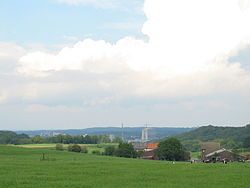Heerlen
|
Heerlen Heële |
|||
|---|---|---|---|
| City and Municipality | |||

Heerlen skyline as seen from the nearby village of Vrouweheide
|
|||
|
|||
 Location in Limburg |
|||
| Coordinates: 50°53′N 5°59′E / 50.883°N 5.983°ECoordinates: 50°53′N 5°59′E / 50.883°N 5.983°E | |||
| Country | Netherlands | ||
| Province | Limburg | ||
| Government | |||
| • Body | Municipal council | ||
| • Mayor | Ralf Krewinkel (PvdA) | ||
| Area | |||
| • Municipality | 45.53 km2 (17.58 sq mi) | ||
| • Land | 45.02 km2 (17.38 sq mi) | ||
| • Water | 0.51 km2 (0.20 sq mi) | ||
| Elevation | 113 m (371 ft) | ||
| Population (Municipality, May 2014; Urban and Metro, May 2014) | |||
| • Municipality | 88,022 | ||
| • Density | 1,955/km2 (5,060/sq mi) | ||
| • Urban | 200,957 | ||
| • Metro | 247,731 | ||
| Demonym(s) | Heerlenaar | ||
| Time zone | CET (UTC+1) | ||
| • Summer (DST) | CEST (UTC+2) | ||
| Postcode | 6400–6433 | ||
| Area code | 045 | ||
| Website | www |
||
Heerlen (Dutch pronunciation: [ˈɦeːrlə(n)]; Limburgish: Heële) is a city and a municipality in the southeast of the Netherlands. It is the fourth largest municipality in the province of Limburg.
Heerlen forms part of Parkstad Limburg, formerly known as Oostelijke Mijnstreek (Eastern Coal Mining District), an agglomeration with about 220,000 inhabitants.
After its early Roman beginnings and a modest medieval period, Heerlen became a centre for the coal mining industry in the Netherlands in the late 19th century. In the 20th century, architect Frits Peutz played a major role in shaping the city as we know it today. His most famous design, and a distinctive building in the city centre, is the so-called Glaspaleis (Glass Palace), listed as one of the world's thousand most architecturally important buildings of the 20th century.
In 1997, a habitation from the Michelsberg culture (4400 - 3500 BC) was excavated at the Schelsberg, near Heerlen. Archeological finds from this period are rare in the Netherlands. The site is unique in the Netherlands, as it is the first excavated site with ditches and earth walls (earthworks).
Even with these proofs of early habitation, the history of Heerlen properly starts with the arrival of the Romans. They founded a military settlement, named Coriovallum on the crossroad of two main roads: Boulogne sur Mer - Cologne and Xanten - Aachen - Trier. In Heerlen and its surroundings a lot of evidence of Roman life has been excavated, especially Roman villas (country estates). The most notable archeological excavation from Roman times is the Thermae complex in the centre of Heerlen, a Roman bathhouse, discovered in 1940. In the Netherlands only a few of these have been found. It is a clear indication that Coriovallum/Heerlen was of some importance. A museum has been built over the Thermae and opened in 1977. The Thermenmuseum also houses other Roman finds from the area.
...
Wikipedia


